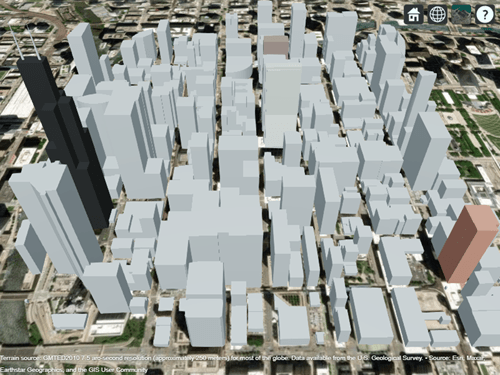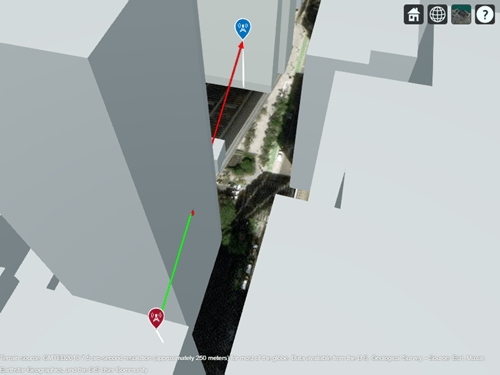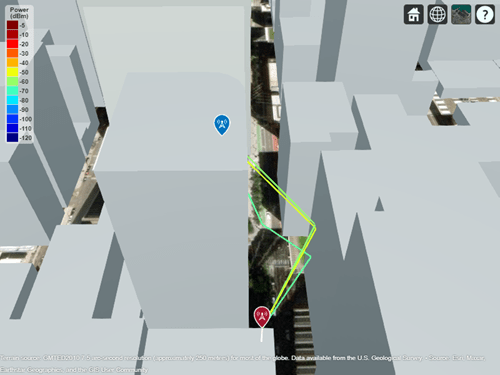plot (rays), plot
Description
plot(
plots the propagation paths for ray objects in the Site Viewer map with additional options
specified by one or more name-value pair arguments.rays,Name,Value)
Examples
Plot Propagation Rays Between Sites in Chicago
Perform ray tracing in Chicago and return the rays in comm.Ray objects. Then, display the rays without performing the ray tracing analysis again.
Launch Site Viewer with buildings in Chicago. For more information about the OpenStreetMap® file, see [1].
viewer = siteviewer(Buildings="chicago.osm");
Create a transmitter site on one building and a receiver site on another building. Show the line-of-sight path between the sites using the los function.
tx = txsite(Latitude=41.8800, ... Longitude=-87.6295, ... TransmitterFrequency=2.5e9); rx = rxsite(Latitude=41.881352, ... Longitude=-87.629771, ... AntennaHeight=30); los(tx,rx)

Create a ray tracing propagation model, which MATLAB® represents using a RayTracing object. By default, the model uses the SBR method and calculates propagation paths with up to two reflections.
pm = propagationModel("raytracing");Perform the ray tracing analysis. The raytrace function returns a cell array containing the comm.Ray objects.
rays = raytrace(tx,rx,pm)
rays = 1×1 cell array
{1×3 comm.Ray}
View the properties of the first ray object.
rays{1}(1)ans =
Ray with properties:
PathSpecification: 'Locations'
CoordinateSystem: 'Geographic'
TransmitterLocation: [3×1 double]
ReceiverLocation: [3×1 double]
LineOfSight: 0
Interactions: [1×1 struct]
Frequency: 2.5000e+09
PathLossSource: 'Custom'
PathLoss: 92.7686
PhaseShift: 1.2945
Read-only properties:
PropagationDelay: 5.7088e-07
PropagationDistance: 171.1462
AngleOfDeparture: [2×1 double]
AngleOfArrival: [2×1 double]
NumInteractions: 1
Close Site Viewer.
close(viewer)
Create another Site Viewer with the same buildings, transmitter site, and receiver site. Then, display the propagation paths. Alternatively, you can plot individual paths by specifying a single ray object, for example rays{1}(2).
siteviewer(Buildings="chicago.osm"); show(tx) show(rx) plot(rays{1},Type="power", ... TransmitterSite=tx,ReceiverSite=rx)

Appendix
[1] The OpenStreetMap file is downloaded from https://www.openstreetmap.org, which provides access to crowd-sourced map data all over the world. The data is licensed under the Open Data Commons Open Database License (ODbL), https://opendatacommons.org/licenses/odbl/.
Input Arguments
rays — Ray configuration object
comm.Ray object
Ray configuration, specified as one comm.Ray
object or a vector of
comm.Ray objects. Each object must have the
PathSpecification property set to
"Locations".
Data Types: comm.Ray
Name-Value Arguments
Specify optional pairs of arguments as
Name1=Value1,...,NameN=ValueN, where Name is
the argument name and Value is the corresponding value.
Name-value arguments must appear after other arguments, but the order of the
pairs does not matter.
Before R2021a, use commas to separate each name and value, and enclose
Name in quotes.
Example: plot(rays,"Type","pathloss","ColorLimits",[-100 0]) adds the
propagation path specified in rays to the current Site Viewer and adjusts
the default color limits.
Type — Quantity type to plot
"pathloss" (default) | "power"
Quantity type to plot, specified as "pathloss" or
"power". Based on the value specified for
Type, the color applied along the path maps to the path loss in
dB or the power in dBm of the signal along the path.
Data Types: char | string
TransmitterSite — Transmitter site
txsite object
Transmitter site, specified as a txsite object.
Dependencies
Applies only when Type is set to
"power".
Data Types: char
ReceiverSite — Receiver site
rxsite object
Receiver site, specified as an rxsite object.
Dependencies
Applies only when Type is set to
"power".
Data Types: char
ColorLimits — Colormap color limits
[-120 -5] or [45 160] (default) | 1-by-2 numeric vector
Color limits for colormap, specified as a 1-by-2 numeric vector,
[min, max], where min
represents the lower saturation limit and max represents the upper
saturation limit. The default is [-120 -5] when Type is set to
'power' and [45 160] when Type is set to
'pathloss'.
Data Types: double
Colormap — Colormap applied to propagation path
'jet' (default) | M-by-3 numeric array
Colormap applied to propagation path, specified as an M-by-3 numeric array of RGB (red,green,blue) triplets that define M individual colors.
Data Types: double | char | string
ShowLegend — Show color legend on map
true (default) | false
Show color legend on map, specified as true or
false.
Data Types: logical
Map — Map for visualization and surface data
siteviewer object
Map for visualization and surface data, specified as a siteviewer
object.1
The default is the current siteviewer object, or if no
Site Viewer is open a new siteviewer object opens.
Data Types: siteviewer object
Version History
Introduced in R2020a
1 Alignment of boundaries and region labels are a presentation of the feature provided by the data vendors and do not imply endorsement by MathWorks®.
MATLAB Command
You clicked a link that corresponds to this MATLAB command:
Run the command by entering it in the MATLAB Command Window. Web browsers do not support MATLAB commands.

Select a Web Site
Choose a web site to get translated content where available and see local events and offers. Based on your location, we recommend that you select: .
You can also select a web site from the following list:
How to Get Best Site Performance
Select the China site (in Chinese or English) for best site performance. Other MathWorks country sites are not optimized for visits from your location.
Americas
- América Latina (Español)
- Canada (English)
- United States (English)
Europe
- Belgium (English)
- Denmark (English)
- Deutschland (Deutsch)
- España (Español)
- Finland (English)
- France (Français)
- Ireland (English)
- Italia (Italiano)
- Luxembourg (English)
- Netherlands (English)
- Norway (English)
- Österreich (Deutsch)
- Portugal (English)
- Sweden (English)
- Switzerland
- United Kingdom (English)